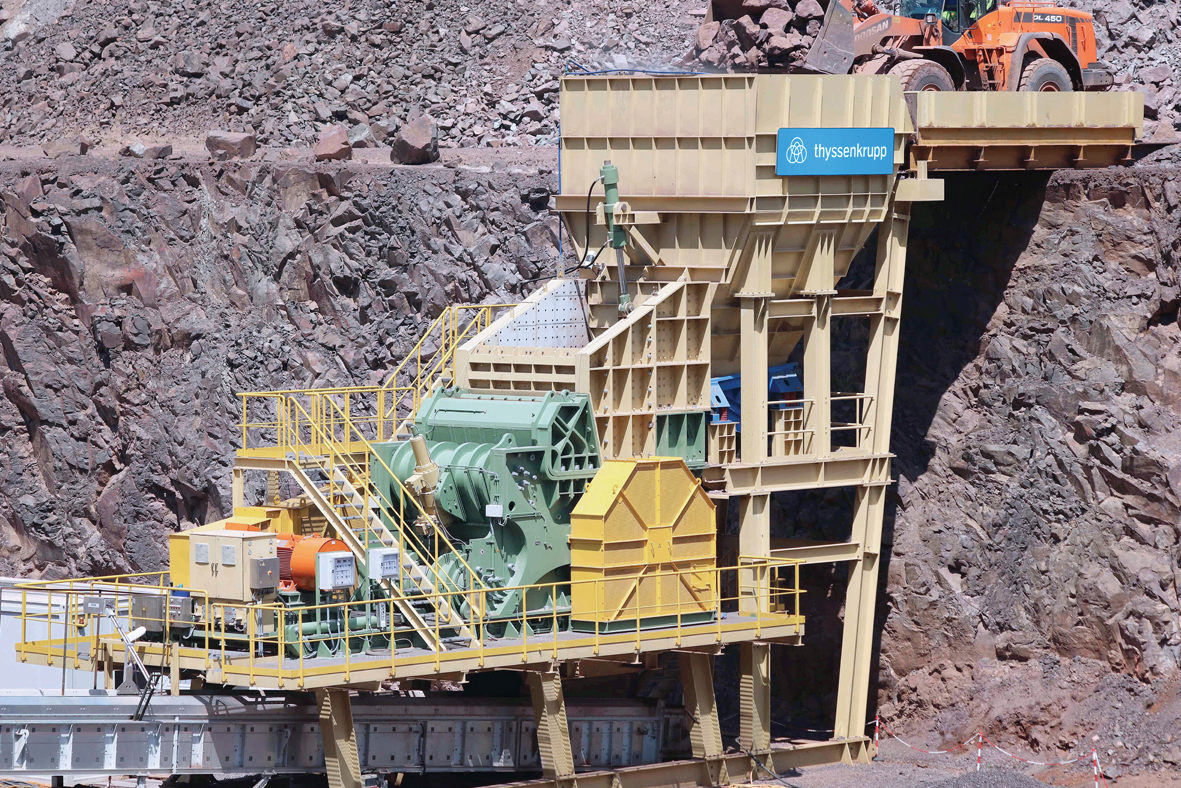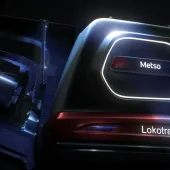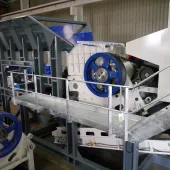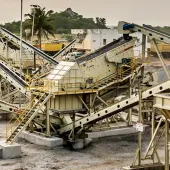Thyssenkrupp Eccentric Roll Crusher

First published in the September 2019 issue of Quarry Management as An Eccentric Solution
Designed initially as a smaller option for primary crushing operations in underground mines, the eccentric roll crusher can be adapted as a workable primary crusher in above-ground quarrying applications.
Compact but powerful, ultra-productive with excellent crushing performance, highly energy efficient and well balanced’. These attributes feature in promotional literature describing the new eccentric roll crusher (ERC) from thyssenkrupp Industrial Solutions. According to the manufacturer, the ERC redefines the concept of primary crushing hard rock. As such, it is suited not only for use in underground operations, but also in open-pit mines and quarries, where its qualities are particularly useful in semi-mobile or fully mobile operations.
For decades, gyratory and jaw crushers have proved their worth in crushing hard rock. However, their application is limited by their high headroom, requiring capital-intensive construction of large-scale, costly caverns when used in underground operations. Moreover, in open-pit operations they are only partially suitable for mobile use because of design-related residual imbalance-induced forces.
Although low-headroom crushers such as double-roll crushers and sizers have become established as primary crushers in the industry, design constraints mean they are not considered capable of efficiently and economically processing hard rock. The new ERC, with its patented design of pre-screening and crushing features, combines compact design and the ability to crush hard rock with high throughputs in an energy-efficient manner.
Operational benefits
The ERC offers significant operational benefits. Its installation height is between 20% and 55% lower than similar-performing gyrator or jaw crusher options, in an overall lighter package. At the same time, the ERC is highly productive and energy efficient. Its kinematics, with a constantly large stroke, are said to promote a more profound crushing intensity and higher throughput rates. High-inertia moments in the roll and flywheels a enhance the ERC’s energy efficiency, while integrated pre-screening device allows for efficient bypassing of fines to significantly reduce power consumption, compaction risk and the wear rate of crushing tools.
The steady rotation of the freely rotatable crushing roll, when exposed to feed material, results in exceptionally uniform wear and high utilization of the crushing tools. The symmetrical arrangement of the eccentrically moved crushing roll allows for easy balancing, so foundation forces and vibrations are reduced to a minimum. As a result, the ERC is particularly suitable for use in semi-mobile or fully mobile applications.
Smart control is another decisive advantage. Thyssenkrupp’s patented hydraulic gap-setting/retraction system allows for safe and simple automatic adjustment of the gap, liner wear compensation and release of tramp metal or other non-crushable material content. Moreover, the ERC is equipped for Industry 4.0, incorporating a comprehensive monitoring system that allows for local or remote control and the automation of equipment parameters from the crusher’s display. In addition, an optional thyssenkrupp data-acquisition system offers reliable recording and storage of relevant operational data for troubleshooting, condition monitoring and preventive maintenance.
Operating principle
Material is fed into the crusher via an apron feeder, push feeder or similar device. Fine particles in the feed are screened out by the integrated static grizzly and bypassed through the crusher housing, while coarse particles are transferred into the crushing chamber. A rotating eccentric shaft, axially guided by two sets of roller bearings mounted in the crusher housing, generates an oscillating movement in the freely rotatable, horizontally arranged crusher roll.
Consequently, the crushing gap between the crusher roll and the jaw in the crusher housing changes continuously, which means the feed material is crushed by compressive forces as it falls by gravity, until the product exits the crushing chamber at the bottom. The eccentric shaft is driven by a V-belt drive, with the inertia of two flywheels mounted on to the shaft accumulating crushing energy (see fig. 2).
The kinematic principle applied in the ERC ensures the stroke remains the same throughout the entire crushing chamber. This special feature significantly increases the comminution intensity compared with commonly used crushers. The jaw itself does not move during the crushing process but is supported by the fully hydraulic gap-setting/retraction system with its patented safety device.
After the detailed design of this roll crusher, a prototype of the machine was built and extensively field-tested in a six-month campaign at a hard rock quarry in Germany. The crusher model ERC 25-25 selected for this purpose has a crushing roll measuring 2,500mm in diameter and width. The feed opening to the crushing chamber is 2,500mm wide and 1,230mm high (see table 1).
Both the coarse and fine run-of-mine feed were processed, together with selected lumps of up to 5 tonnes. The equipment parameters were varied with regard to eccentric shaft speed and gap closed-side setting (CSS). The corresponding operating data were collected with and without the integrated grizzly.
Pilot plant
During this pilot operation, average capacities of 2,000 to 3,000 tonnes/h were recorded. The desired product size of 0–200/x mm was achieved at various settings, with P80 at a CSS of 140mm recorded at around 130mm. The integrated grizzly effectively bypassed fines and contributed between 30% and 40% of the total equipment capacity. Power consumption at nominal capacity ranged between 200kW and 500kW, depending on crusher settings. However, the high energy efficiency of the ERC was confirmed by the power consumption of 0.1–0.2kWh per tonne.
The ERC from thyssenkrupp offers new standards in the primary crushing of hard rock thanks to features not found in conventional crushers, thereby opening up numerous new application areas in the processing of mineral raw materials. The ERC roll crusher series comprises four units, ranging from the ERC 18-14 entry model to the top-end ERC 25-34 model, with throughputs ranging between 600 and 10,000 tonnes/h. The first ERC for commercial operation – the ERC 25-25, capable of generating an output of 8,000 tonnes/h – has already been sold and was shown at the bauma trade exhibition in Munich, Germany, earlier this year.
‘We are constantly seeking new solutions for our customers that improve crusher availability and efficiency, and reduce installation and operating costs,’ said Detlef Papajewski, head of mineral processing at thyssenkrupp Industrial Solutions’ mining technologies business unit. ‘With the new ERC, we have developed a technology that is the first of its kind. Its innovative design combines the advantages of conventional primary crushers with solutions to their typical disadvantages, such as large height. As a result, the ERC can be used in both underground and surface mining operations, and in quarries, to process ore and hard rock more effectively.’
ACKNOWLEDGEMENT
This article first appeared in the April 2019 issue of Quarry, the official journal of the Institute of Quarrying Australia, and is reprinted here by kind permission.
- Subscribe to Quarry Management, the monthly journal for the mineral products industry, to read articles before they appear on Agg-Net.com








